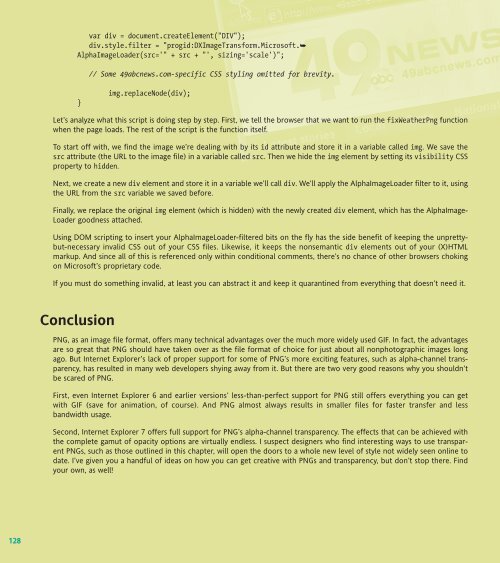WEB STANDARDS CREATIVITY
WEB STANDARDS CREATIVITY
WEB STANDARDS CREATIVITY
You also want an ePaper? Increase the reach of your titles
YUMPU automatically turns print PDFs into web optimized ePapers that Google loves.
128<br />
var div = document.createElement("DIV");<br />
div.style.filter = "progid:DXImageTransform.Microsoft.➥<br />
AlphaImageLoader(src='" + src + "', sizing='scale')";<br />
}<br />
// Some 49abcnews.com-specific CSS styling omitted for brevity.<br />
img.replaceNode(div);<br />
Let’s analyze what this script is doing step by step. First, we tell the browser that we want to run the fixWeatherPng function<br />
when the page loads. The rest of the script is the function itself.<br />
To start off with, we find the image we’re dealing with by its id attribute and store it in a variable called img. We save the<br />
src attribute (the URL to the image file) in a variable called src. Then we hide the img element by setting its visibility CSS<br />
property to hidden.<br />
Next, we create a new div element and store it in a variable we’ll call div. We’ll apply the AlphaImageLoader filter to it, using<br />
the URL from the src variable we saved before.<br />
Finally, we replace the original img element (which is hidden) with the newly created div element, which has the AlphaImage-<br />
Loader goodness attached.<br />
Using DOM scripting to insert your AlphaImageLoader-filtered bits on the fly has the side benefit of keeping the unprettybut-necessary<br />
invalid CSS out of your CSS files. Likewise, it keeps the nonsemantic div elements out of your (X)HTML<br />
markup. And since all of this is referenced only within conditional comments, there’s no chance of other browsers choking<br />
on Microsoft’s proprietary code.<br />
If you must do something invalid, at least you can abstract it and keep it quarantined from everything that doesn’t need it.<br />
Conclusion<br />
PNG, as an image file format, offers many technical advantages over the much more widely used GIF. In fact, the advantages<br />
are so great that PNG should have taken over as the file format of choice for just about all nonphotographic images long<br />
ago. But Internet Explorer’s lack of proper support for some of PNG’s more exciting features, such as alpha-channel transparency,<br />
has resulted in many web developers shying away from it. But there are two very good reasons why you shouldn’t<br />
be scared of PNG.<br />
First, even Internet Explorer 6 and earlier versions’ less-than-perfect support for PNG still offers everything you can get<br />
with GIF (save for animation, of course). And PNG almost always results in smaller files for faster transfer and less<br />
bandwidth usage.<br />
Second, Internet Explorer 7 offers full support for PNG’s alpha-channel transparency. The effects that can be achieved with<br />
the complete gamut of opacity options are virtually endless. I suspect designers who find interesting ways to use transparent<br />
PNGs, such as those outlined in this chapter, will open the doors to a whole new level of style not widely seen online to<br />
date. I’ve given you a handful of ideas on how you can get creative with PNGs and transparency, but don’t stop there. Find<br />
your own, as well!















